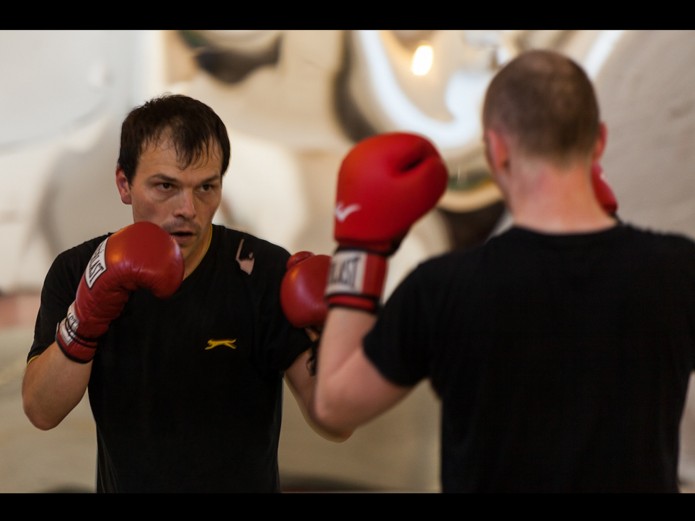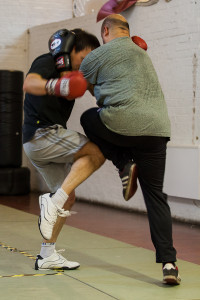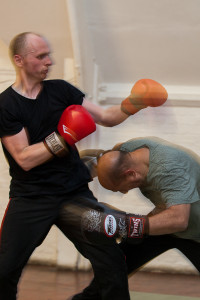Practical self-defence applications exist for all the movements of the Taiji Hand Form – in our classes we drill these movements repeatedly to develop them as reflexive responses. This practice can be done slowly to develop technique, and later more energetically to simulate a realistic self-defence situation or for pushing hands/sanshou competition training.
Category Archives: Martial Class
Fixed Step Pushing Hands
Video of fixed step pushing hands training with class members Debbie and James – and clips of application of these grappling skills to set up striking and throwing in sanshou competition by Chris and Vince.
Pushing Hands in Competition
The video below shows members of our club taking part successfully in national Pushing Hands competitions.

Martial Class Hand Form
After an energetic training session in our martial classes, we cool down by performing the Taiji hand form.
Taking 15-20 minutes to perform in total, the slow movements effectively perform the function of a therapeutic warm-down, encouraging the muscles and joints to move through their range of motion while operating at a reduced intensity. Meanwhile, one gains all the other benefits of practising the hand form – one works through an efficient template of the style’s martial movements while training balance, co-ordination and focus.
The tiredness experienced after expending energy in pushing hands practice and sparring also helps encourage relaxation and efficient use of minimum muscular tension, which also benefits one’s practice of the form.
Below are some photos taken during a martial class (photography by Steve Musselwhite).
Padwork – University Class
As well as training strong and efficient punching technique, practising Running Thunder Hand (continuous punching) in pairs using gloves and focus mitts trains holding a protective guard (shoulder muscles) and, since punching should involve the whole body – legs, core and arms – this acts as a general stamina conditioning exercise as well.
The video clip below shows two members of the student class working on some striking combinations (punches, knees and elbows) using pads.
Martial Application – Sweep Lotus Leg
Dave and Vince demonstrating the form and application for the move Sweep Lotus Leg, including some footage of this technique being applied in Sanshou competition by Vince. If you look closely you can see Royce Gracie sat up behind somewhere watching!
Martial Application – Brush Knee Twist Step
Dave and Vince demonstrating the form and application for the move Brush Knee Twist Step, including some footage of this technique being applied in sanshou competition by Vince and Chris.
San Shou competition
Video of Oxford Wudang student Vince competing in a national San Shou event, demonstrating Vince’s devastating striking skills.
Yang overcomes Yin
While much is made of using Yin (softness) to overcome Yang (hardness) in Taiji literature, the converse is also true.
When the opponent’s defence is weakened, the Taiji practitioner can take the initiative to attack strongly (Yang) to overcome the opponent’s weakness (Yin).
Below is a short clip of Oxford Wudang student Chris taking part in a full-contact sanshou competition and demonstrating this concept…

Sparring (SanShou)
Today Taijiquan is well-known as a health system. However, it is also an effective martial art and was once taught to Manchurian Bannerman and Qing princes who ruled China at the time of Taijiquan’s rise to prominence.
 Traditionally, martial artists in China tested their skills against other styles at lei tai events, where fighters would compete on a raised platform without ropes. Originally these contests would have been no-holds-barred. However, nowadays rules have been introduced to ensure the safety of competitors while still maintaining a realistic level of contact. Modern san shou competition rules can be broadly compared to kickboxing with stand-up wrestling and penalties given for being driven off the platform.
Traditionally, martial artists in China tested their skills against other styles at lei tai events, where fighters would compete on a raised platform without ropes. Originally these contests would have been no-holds-barred. However, nowadays rules have been introduced to ensure the safety of competitors while still maintaining a realistic level of contact. Modern san shou competition rules can be broadly compared to kickboxing with stand-up wrestling and penalties given for being driven off the platform.
 The lineage of Oxford Wudang has preserved the Taijiiquan fighting heritage, and our club has had many members who have competed in full-contact competitions, including national champions.
The lineage of Oxford Wudang has preserved the Taijiiquan fighting heritage, and our club has had many members who have competed in full-contact competitions, including national champions.
This level of training is not for everyone; those who are willing to put in the effort and commitment can participate in sparring sessions during our martial classes, beginning with light contact and moving up to full-contact training as skill and conditioning progresses. All other aspects of the training – forms, pushing hands (grappling) training, practical applications drills, padwork & conditioning training – feed into and inform this live training practice.
Below is a slideshow album of photographs taken during a recent sparring session (Photography by Steve Musselwhite). Due to the fast-paced nature of bouts it’s very difficult to capture moments perfectly on film, so we’re grateful that Steve has managed to take some very good photos here…!